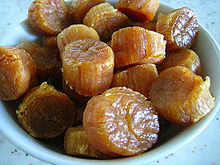- Conpoy
-
Conpoy 
Traditional Chinese 江 瑤 柱 Simplified Chinese 江 瑶 柱 Literal meaning river scallop Transcriptions Mandarin - Hanyu Pinyin jiāng yáo zhù Cantonese (Yue) - Jyutping gong1 jiu4 cyu5 Alternative Chinese name Traditional Chinese 乾瑤柱 Simplified Chinese 干瑶柱 Literal meaning dried scallop Transcriptions Mandarin - Hanyu Pinyin gan1 qian2 zhu4 Cantonese (Yue) - Jyutping gon1 jiu4 cyu5 Conpoy or dried scallop is a type of dried seafood product made from the adductor muscle of scallops.[1] The smell of conpoy is marine, pungent, and reminiscent of certain salt-cured meats. Its taste is rich and umami due to its high content of various free amino acids, such as glycine, alanine, and glutamic acid. It is also rich in nucleic acids such as inosinic acid, amino acid byproducts such as taurine, and minerals, such as calcium and zinc.
Conpoy is produced by cooking raw scallops and then drying them. Proper execution of these two steps as well as the freshness of the original raw product is essential to the quality of the final dried product.
Contents
Terminology
Conpoy is a loanword from the Cantonese pronunciation of gonbui (乾 貝, Cantonese: gon1bui³; Mandarin: gān bèi ; Hakka:gorn boy), which literally means "dried shell(fish)".
When used for cuisines and sliced up for cooking, it is generally referred to as (乾 瑤 柱)
Usage
In Hong Kong, conpoy from two types of scallops are common. Conpoy made from Atrina pectinata or kongyiu (江珧), a freshwater scallop from mainland China, is small and milder in taste. Patinopecten yessoensis or sinpui (扇貝), a sea scallop imported from Japan (hotategai, 帆立貝 in Japanese), produces a conpoy that is stronger and richer in taste.
Like many dried foods, conpoy was originally made as a way to preserve seafood in times of excess.[2] In more recent times its use in cuisine has been elevated to gourmet status. Conpoy has a strong and distinctive flavor that can be easily identified when used in rice congee, stir fries, stews, and sauces.
XO sauce, a seasoning used for frying vegetables or seafoods in Cantonese cuisine, contains significant quantities of conpoy.
See also
References
- ^ Simonds, Nina (2005-06-20). Food of China. Murdoch Books. p. 289. ISBN 9781740454636. http://books.google.com/books?id=-9XWQrpbLAgC&pg=PA289. Retrieved 12 January 2011.
- ^ Tsai, Ming; Boehm, Arthur (1999-11-09). Blue Ginger: East Meets West Cooking with Ming Tsai. Clarkson Potter. p. 7. ISBN 9780609605301. http://books.google.com/books?id=SdTF3KznjJ0C&pg=PA7. Retrieved 12 January 2011.
Categories:- Seafood
- Food ingredients
- Chinese ingredients
- Dried meat
- Cuisine stubs
Wikimedia Foundation. 2010.

